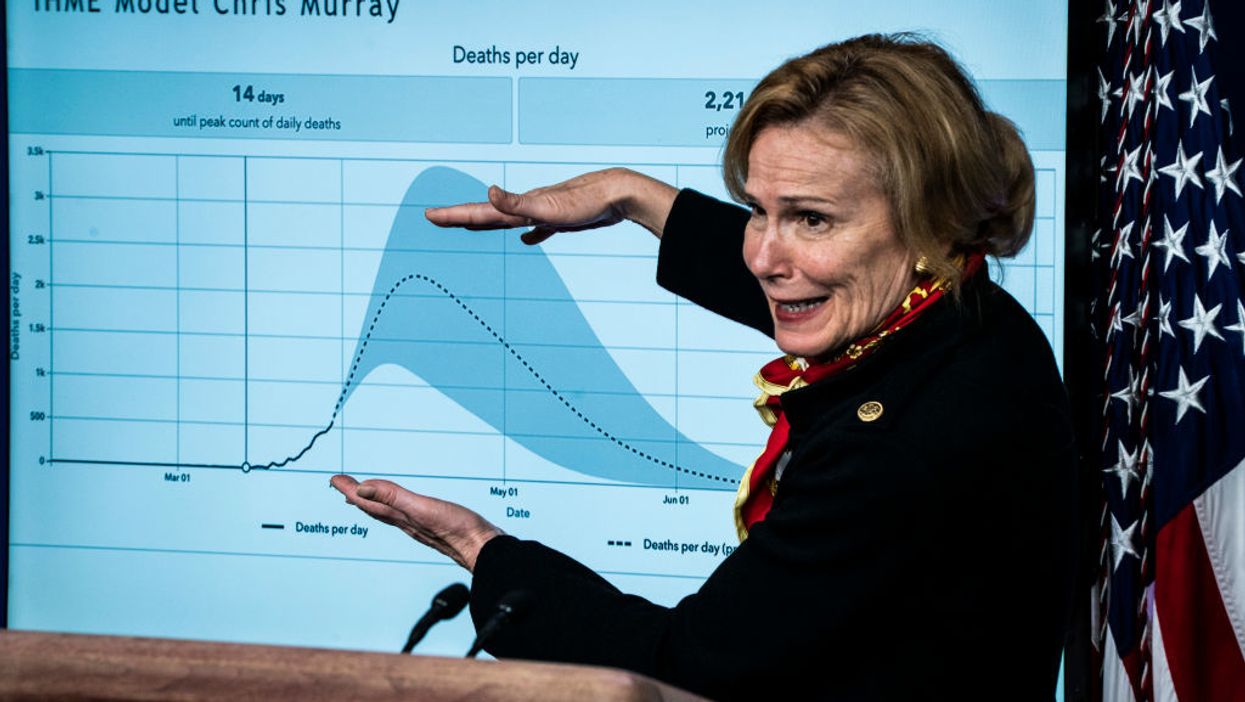
Dr. Deborah Birx of the White House coronavirus task force. (Photo by Jabin Botsford/The Washington Post via Getty Images)

All the major models, in one place
Over the last several weeks, Americans have been inundated with a profusion of projected figures regarding the coronavirus pandemic in wild diversity. With just a quick internet search, one could find death toll projections ranging from tens of thousands to well over 1 million, all of which cite "models" put together by "experts."
When looking at all the models, the question becomes: Is there a trend? In order to answer that question, TheBlaze analyzed information from several of the major models predicting the extent of the outbreak in America looking for key data such as the date the model was published, the number of U.S. deaths it predicted, and whether social distancing efforts were taken into account.
After our analysis, we have concluded that, generally speaking, as later models have taken social distancing efforts into account, their projected death tolls have reduced significantly.
Early models predicted a grim outcome but often explicitly said that the numbers might be much lower if mitigation measures, including social distancing, were implemented.
Since social distancing measures have been put into place, generally speaking, the models have been revised downward and began taking into account the likelihood that social distancing would continue. The revisions since then have been relatively minor.
It makes sense that the early models would not take social distancing into account because governments didn't start enacting intervention measures until mid-to-late March, by the time early models had already been published.
Below are the models we analyzed, listed in chronological order according to the dates they were released:
Additional information: Frieden's model bases projections on the case fatality ratio of COVID-19 and the percentage of the population infected. In projecting the worst-case scenario of more than 1.6 million deaths, Frieden assumes the case fatality ratio to be 1% and that 50% of the population will be infected. He adds that "aggressive action [community mitigation measures] could minimize the impact of the virus in the United States." Thus, this model was explicitly based on the assumption that no social distancing would occur.
Additional information: The projections were based on four different scenarios presented by Biggerstaff on a phone call with experts from universities around the world. The scenarios were depicted in terms of percentages of the population and then translated into absolute numbers by independent experts. In regard to social distancing measures, the New York Times reported that the model's "worst-case figures would be staggering if no actions were taken to slow transmission," indicating that the larger death toll figures assumed no social distancing intervention.
Additional information: The Imperial College model was the key factor that triggered a sudden shift toward stricter social distancing measures in the U.K. and the U.S. But it should be noted that on March 25, Ferguson drastically reduced his model's expected death toll in the U.K. from 510,000 to 20,000 or fewer. He added at that time that he did not expect the country's health care system to be overwhelmed by the pandemic. Though he did not give an update on U.S. projections, it is reasonable to assume that the projected death toll for the U.S. would be drastically reduced, as well. Ferguson said that new information about the virus' transmissibility caused him to rework the model. He also pointed to the success of social distancing efforts, but this claim is difficult to prove as the efforts had only just been enacted.
Additional information: The 18 disease-modeling experts, largely from universities in the U.S., were asked to complete a survey detailing their expert opinion on the trajectory of the COVID-19 outbreak in the US. The surveys were administered over five weeks, ending with a final survey administered March 16-17. The collective results featured a broad range of projected deaths from 19,000 to 1.2 million. However, experts did generally expect "(i) the number of COVID19 cases to continue to rise, (ii) that a second wave of infections will occur in the fall, and (iii) that COVID infections could cause 200K deaths in the US by the end of 2020."
Additional information: Task force members announced the model during a White House press briefing on March 31, suggesting that the death toll would have been 1.5 million to 2.2 million without intervention, but with intervention the projected death toll is 100,000 to 240,000. The task force came up with its figures by "combining the Imperial College in London model with a half-dozen other models from leading epidemiology teams around the world," according to NBC News. Also during the briefing, President Trump announced that he would extend his social distancing guidelines at least until the end of April.
Additional information: The IHME model is a preferred model of the White House coronavirus task force, and is often cited during task force press briefings. In addition to the national death toll projection, the IHME model also predicts peak daily death tolls for individual states as well as hospital resource information, such as how many hospital beds, intensive care unit beds, and ventilators are in supply and will be required in each state. On April 6, the IHME revised its estimates downward (to the totals displayed above), finding that "need for hospital beds, ICU beds, and ventilators needed to deal with the COVID-19 epidemic are less than previously estimated," according to a news release.